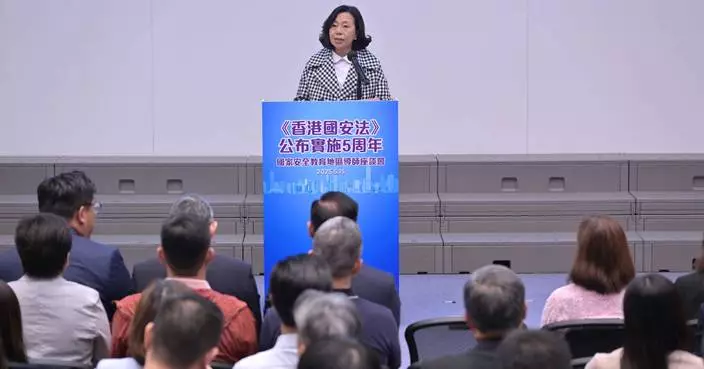Survey results of 2024 Annual Earnings and Hours Survey released
Monthly wage
According to the statistics released today (March 24) by the Census and Statistics Department (C&SD), the median monthly wage of employees in Hong Kong in May – June 2024 was $20,500. This was 3.6% higher than the median of $19,800 in May – June 2023.
The change in monthly wage in 2024 when compared with 2023 is useful in reflecting the change in take-home pay of employees between these two years.
In May – June 2024, the 10th, 25th, 75th and 90th percentile monthly wages of Hong Kong employees were $10,700, $14,800, $32,000 and $50,000 respectively. They were 3.1%, 3.6%, 2.8% and 3.1% higher than the corresponding figures in May – June 2023 respectively (Table1).
As shown in Table2, increase in median monthly wage was observed for both male and female employees and for all age groups, educational attainments, occupational groups and industry sections.
Hourly wage
The median hourly wage of employees in Hong Kong in May – June 2024 was $82.9, 3.5% higher than the median of $80.1 in May – June 2023. The 5th, 10th, 25th, 75th and 90th percentile hourly wages were $46.1, $49.3, $59.2, $131.5 and $209.3 respectively. The overall hourly wage distribution of employees is shown in Table3. The number of employees analysed by selected hourly wage level is shown in Table4.
In May – June 2024, the median hourly wage of male employees was $93.3 while that of female employees was $73.2. Analysed by age group, the median hourly wage of employees at age 35 – 44 was the highest ($97.2), followed by employees at age 25 – 34 ($86.7) and at age 45 – 54 ($83.9). The median hourly wages of employees of different sexes, age groups, educational attainments, occupational groups and industry sections are given in Table5.
Further information
The above wage statistics were compiled based on the data obtained from the 2024 Annual Earnings and Hours Survey (AEHS). The purpose of the survey is to provide comprehensive data on the level and distribution of wages, employment details and demographic profile of employees in Hong Kong. These statistics are useful for studies on labour-related topics by the private sector and the Government. They also provide important inputs for analyses related to the Statutory Minimum Wage. A sample of about 10000 business undertakings was selected for the survey.
Wage(s) is defined to include basic wage, commission and tips not of gratuitous nature, guaranteed bonuses and allowances, and overtime allowance paid to an employee in the survey period. It does not cover bonuses and allowances of gratuitous nature, end of year payment and payments in kind. Number of working hours is the sum of contractual/agreed working hours (including meal breaks if they are regarded as working hours according to the employment contract or agreement with the employer) and overtime hours worked at the direction of employers.
By arranging the hourly wages of all employees from the smallest to the largest value, the median hourly wage is the hourly wage of the employee who ranks in the middle of all the employees concerned. In other words, the median hourly wage is the hourly wage value that delineates the lowest 50% of all the employees concerned.
Percentile hourly wage figures are useful in discerning the distribution of hourly wage of employees. The pth percentile hourly wage is the hourly wage value which delineates the lowest p% of all the employees concerned, where p can be any integer value from 1 to 99. For instance, the 10th percentile hourly wage is the hourly wage value that delineates the lowest 10% of the employees. The 25th percentile, 50th percentile and 75th percentile hourly wages are also known as the lower quartile, median and upper quartile hourly wages respectively.
The median and percentile monthly wage figures are derived similarly as the median and percentile hourly wage figures.
Regarding the survey coverage, the AEHS covers all business undertakings irrespective of their employment sizes and industries, except those engaged in agriculture, forestry and fishing activities. All employees of business undertakings falling within the scope of the survey who are under the coverage of the Minimum Wage Ordinance (MWO) are included in the survey. Government employees as well as student interns, work experience students and live-in domestic workers as exempted by the MWO are excluded. As it is necessary to derive the hourly wage of employees from their monthly wages and hours of work, those employees with zero working hours in the survey reference period are also excluded.
Details of the wage statistics compiled from the 2024 AEHS and the survey methodology are given in the 2024 Report on Annual Earnings and Hours Survey. Users can browse and download thepublicationatthewebsiteoftheC&SD(www.censtatd.gov.hk/en/EIndexbySubject.html?pcode=B1050014&scode=210).
Enquiries concerning the survey results of the AEHS can be directed to the Wages and Labour Costs Statistics Section (2) of the C&SD at 31052369.







